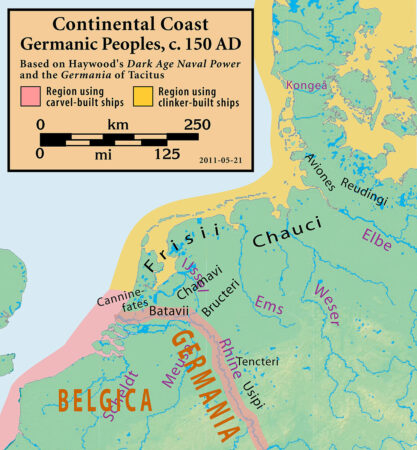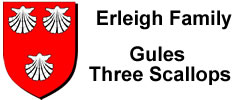The Germanic tribes
The Germanic tribes seem to have originated in a homeland in southern Scandinavia (Sweden and Norway, with the Jutland area of northern Denmark, along with a very narrow strip of the Baltic coastline). They had been settled here for over two thousand years following the Indo-European migrations. The Germanic ethnic group began as a division of the western edge of late proto-Indo-European dialects around 3300 BC, splitting away from a general westwards migration to head towards the southern coastline of the Baltic Sea. By the time the Germanic tribes were becoming key players in the politics of Western Europe in the last two centuries BC, the previously dominant Celts were on the verge of being conquered and dominated by Rome. They had already been pushed out of northern and Central Europe by a mass of Germanic tribes which were steadily carving out a new homeland.
The Batavi and Canninefates are conquered by Rome by 4 BC (and perhaps a decade earlier) and become subjects of the empire. At this time these tribes still live in small villages of up to a dozen houses located on very fertile land near the rivers. They also value horses highly, with some being included in burials.
The Batavi Tribe
According to Tacitus, the Batavi were originally a constituent part of the Chatti tribe before they migrated westwards before the first century AD. They settled in the central Netherlands (now immediately north of the border with Belgium) with the Frisians to their north, the Bructeri to the east, the Paemani, the Belgic Menapii and Germanic Ubii to the south, and the Canninefates to the west (a tribe that was related to the Batavi). The core of their territory was focused on modern Betuwe, which lies between the Waal and the Meuse, and central North Brabant (close to modern Nijmegen). Noted by Tacitus in AD 98, their home was painted as ‘an uninhabited district on the extremity of the coast of Gaul, and also of a neighboring island, surrounded by ocean in front, and by the River Rhenus (the Rhine) in the rear and on either side. Wooden tablets have been uncovered from Batavi settlement areas, showing that, unusually, these people had a system of writing.
The tribe’s name can be broken down as follows: ‘bat-‘ [e; f. I.], meaning ‘contention, strife’, plus the suffix ‘-au -a -aue’, which is related to rivers or water (see the German words ‘au’ or ‘aue’). This meaning of ‘-au’, which has an earlier spelling of ‘ow, owe, ouwe’, describes settlements beside streams and rivers. An example is Passau, or a town by the name of Aue, or rivers named Aue. In which case, the Batavi were ‘the battlers by the river’, in this case the Rhine. An alternative interpretation of ‘bat’ is taken from the Germanic ‘good, excellent’, which is also the origin of the English word ‘better’. This would make them the ‘good river settlement [people]’, but using ‘bat’ as ‘good’ is less fierce than using ‘ba∂’ as ‘battle’ (reference: *ba∂wò – sb.f. – Old Norse ‘bo∂’, meaning ‘battle’, Old English ‘beadu’, meaning ‘battle, war’, Old Saxon ‘badu-‘ (in cmpn.), and Old High German ‘batu-‘ (in cmpn.) – cf. Burg *badus id.
The Batavi were absorbed by the Salian Franks at the end of the third century AD. However, their name has retained a resonance with later Netherlanders, possibly due to the area in which they lived being Latinised as insula Batavorum. The name Batavia was used by the Dutch when they fought the War of Liberation (1568-1648), part of the drive for independence from the Spanish Habsburgs. Revolutionary France also created a client state known as the Batavian republic in 1795. Today the area is known as Betuwe (with the ‘w’ being pronounced as a ‘v’ sound).
The Canninefates Tribe
 This tribe was located in what is now the southern Netherlands, on the southern side of the mouth of the Rhine (below modern Utrecht and The Hague), and on both sides of the mouth of the Maas. They were bordered by the Frisii to the north-east, the Batavi to the east, and the Paemani and the Belgic Menapii to the south. During the first century AD, their territory was incorporated by Rome into the province of Germania Inferior.
This tribe was located in what is now the southern Netherlands, on the southern side of the mouth of the Rhine (below modern Utrecht and The Hague), and on both sides of the mouth of the Maas. They were bordered by the Frisii to the north-east, the Batavi to the east, and the Paemani and the Belgic Menapii to the south. During the first century AD, their territory was incorporated by Rome into the province of Germania Inferior.
Inhabiting part of the Insula Batavorum, this small tribe is commonly held to have been closely related to the neighboring Batavi, if not a direct division of that larger tribe. The Batavi were originally a constituent part of the Chatti before they migrated westwards before the first century AD. Once settled, the Canninefates probably occupied the western part of the Insula, the Rhynland, Delftland, and Schieland. Going by Ptolemy, Walckenaer extends the limits of the Insula Batavorum to the north of Leyden, reaching Zandwoort, and he gives the same extension to the Canninefates.
The tribe’s name is an odd one. Variously listed as Cananefates, Caninefates, or even Canenefatae, the meaning generally given is ‘leek masters’ – not a very warlike name. Apparently, the sandy soil of the Rhine delta was perfect for onion growing (and is now just as good for tulip fields).
Julius Caesar notes in his Commentaries on the Gallic War that the Batavi live on an island in the Rhine delta. The location is easily defendable and gives its people an unimpeded view deep into Germany beyond the Rhine (ie. outside the Roman dominions).
This description of the Batavi (and the Canninefates) must be at a point very shortly after the tribe has migrated into the region. They replace earlier Celtic peoples as the dominant force, but whether they entirely displace the Celts or absorb them and become a new ruling elite is unknown. Equally unknown is their language, whether it remains Germanic, or if it absorbs Belgo-Gallic elements from the locals. It is equally possible that they may straddle both definitions.
c.13 – 11 BC
At the start of campaigns that lead to the Cherusci being subjugated by Rome, Nero Drusus, stepson of the emperor, is appointed governor of the Rhine region of Gaul (13 BC). One of his first acts is to beat back an invading tribe that has crossed the Rhine to attack Roman settlements.
It is in this period that Drusus probably builds a massive castra (fortress) and an imperial headquarters on the island of the Batavi. This is curious, given that the normally accepted date of their conquest by Rome is a decade later. Either it is wrong, or the Batavi accept client status perhaps a decade before being fully conquered and subjugated.
Entrance into Brittain
Tacitus (De origine et situ Germanorum XXIX) described the Batavi as the bravest of the tribes of the area, hardened in the Germanic wars, with cohorts under their own commanders transferred to Britannia. They retained the honour of the ancient association with the Romans, not required to pay tribute or taxes and used by the Romans only for war: “They furnished to the Empire nothing but men and arms”, Tacitus remarked. Well regarded for their skills in horsemanship and swimming—for men and horses could cross the Rhine without losing formation, according to Tacitus. Dio Cassius describes this surprise tactic employed by Aulus Plautius against the “barbarians”—the British Celts— at the battle of the River Medway.
The Battle of the Medway took place in 43 AD, probably on the River Medway in the lands of the Iron Age tribe of the Cantiaci, now the English county of Kent. Other locations for the battle have been suggested but are less likely. This was an early battle in the Claudian invasion of Britain, led by Aulus Plautius. On the news of the Roman landing, the British tribes united to fight them under the command of Togodumnus and his brother Caratacus of the Catuvellauni tribe. After losing two initial skirmishes in eastern Kent, the natives gathered on the banks of a river further west to face the invaders.
At the same time, the Romans received the surrender of the Dobunni tribe in western Britain. The Dobunni were subjects of the Catuvellauni, and this diplomatic gain was probably a blow to native morale and manpower.
The Batavi were used to form the bulk of the Emperor’s personal Germanic bodyguard from Augustus to Galba. They also provided a contingent for their indirect successors, the Emperor’s horse guards, the Equites singulares Augusti.
A Batavian contingent was used in an amphibious assault on Ynys Mon (Anglesey), taking the assembled Druids by surprise, as they were only expecting Roman ships.
Numerous altars and tombstones of the cohorts of Batavi, dating to the second century and third century, have been found along Hadrian’s Wall, notably at Castlecary and Carrawburgh. As well as in Germany, Yugoslavia, Hungary, Romania and Austria.
The Batavi and the Heruli Connection
The Heruli people later became an auxilia palatina unit of the Late Roman army, active between the 4th and the 5th century. This Heruli unit was composed of 500 soldiers. They were the heirs of early the germanic tribal groups that were initially used as auxiliary units of the Roman army and later integrated in the Roman Empire after the Constitutio Antoniniana (250AD). Their name was derived from the people of the Heruli. In the sources they are usually recorded together with the Batavi, and it is probable the two units fought together. At the beginning of the 5th century two related units are attested, the Heruli seniores in the West and the Heruli juniores in the East.
